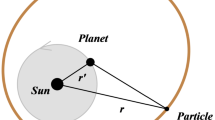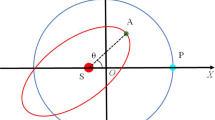Abstract
The 2:3 and 3:4 exterior mean motion resonances with Neptune are studied by applying symplectic mapping models. The mappings represent efficiently Poincaré maps for the 3D elliptic restricted three body problem in the neighbourhood of the particular resonances. A large number of trajectories is studied showing the coexistence of regular and chaotic orbits. Generally, chaotic motion depletes the small bodies of the effective resonant region in both the 2:3 and 3:4 resonances. Applying a low frequency spectral analysis of trajectories, we determined the phase space regions that correspond to either regular or chaotic motion. It is found that the phase space of the 3:4 resonant motion is more chaotic than the 2:3 one.
Similar content being viewed by others
References
Chiang, E. I. and Jordan, A. B.: 2002, ‘On the Plutinos and Twotinos of the Kuiper belt'. A. J. 124, 3430–3444.
Collander-Brown, S. J., Melita, M. D., Williams, I. P. and Fitzsimmons, A.: 2003, ‘The plane of the EKB belt'. Icarus 162, 22–26.
Duncan, M. J., Quinn, T. R. and Tremaine, S.: 1988, ‘The origin of short-period comets'. ApJ. 328, L69–L73.
Duncan, M. J., Levison, H. F. and Budd, S. M.: 1995, ‘The dynamical structure of the Kuiper belt', Astron. J. 110, 3073–3081.
Ferraz-Mello, S.: 1994, ‘The convergence domain of the Laplacian expansion of the disturbing function'. Cel.Mech. Dyn. Astr. 58, 37–52.
Friedland, L.: 2001, ‘Migration timescale thresholds for resonant capture in the Plutino problem', ApJ. 547, L75–L79.
Froeschlé, Cl., Gonczi, R. and Lega, E.: 1997, ‘The fast Lyapunov indicator: a simple tool to detect weak chaos'. Planet. Space Sci. 45, 881–886.
Gallardo, T. and Ferraz-Mello, S.: 1997, ‘Understanding libration via time-frequency analysis', Astron. J. 113(2), 862–869.
Gallardo, T. and Ferraz-Mello, S.: 1998, ‘Dynamics of the 2:3 exterior resonance with Neptune', Planet Space Sci. 46, 945–965.
Gomes, R. S.: 2003, ‘The origin of the KB high-inclination population'. Icarus 161, 404–418.
Goździewski, K., Bois, E., Maciejewski, A. J. and Kiseleva-Eggleton, L.: 1991, ‘Global dynamics of planetary systems with the MEGNO criterion'. Astron. Astroph. 378, 569–586.
Hadjidemetriou, J. D.: 1998, ‘Symplectic maps and their use in celestial mechanics'. In: D. Benest and C. Froeschlé (eds), Analysis and Modelling of Discrete Dynamical Systems, Gordon & Breach, The Netherlands.
Hadjifotinou, K. G. and Hadjidemetriou, J. D.: 2002, ‘A symplectic mapping model for the study of 2:3 resonant trans-Neptunian motion'. Cel. Mech. Dyn. Astr. 84, 135–157.
Jewitt, D.: 1999, ‘Kuiper belt objects'. Annu. Rev. Planet. Sci. 27, 287–312.
Knežević, Z., Milani, A., Farinella, P., Froeschlé, Ch. and Froeschlé, C.: 1991, ‘Secular resonances from 2 to 50AU, Icarus 93, 316–330.
Kotoulas, T. A. and Hadjidemetriou, J. D.: 2002, ‘Resonant periodic orbits of trans-Neptunian objects'. Earth Moon Planets 91, 63–93.
Kotoulas, T. A. and Hadjidemetriou, J. D.: 2003, ‘Dynamical evolution of trans-Neptunian objects near the 3/4 resonance'. Earth Moon Planets (submitted).
Laskar, J.: 1993, ‘Frequency analysis for multidimensional systems. Global dynamics and diffusion', Phy. D, 67, 257–281.
Malhotra, R.: 1996, ‘The phase space near Neptune resonances in the Kuiper Belt'. Astron. J. 111(1), 504–516.
Melita, M. D. and Brunini, A.: 2000, ‘Comparative study of mean-motion resonances in the trans-Neptunian region'. Icarus 147, 205–219.
Michtchenko, T. and Ferraz-Mello, S.: 1995, ‘Comparative study of the asteroidal motion in the 3/2 and 2/1 resonances'. Astron. Astrophys. 303, 945–963.
Michtchenko, T. and Ferraz-Mello, S.: 2001, ‘Resonant structure of the outer solar system in the neigbourhood of the planets'. Astron. J. 122, 474–481.
Milani, A. and Nobili, A.: 1992, ‘An example of stable chaos in the solar system'. Nature, 357, 569–571.
Morbidelli, A.: 1997, ‘Chaotic diffusion and the origin of comets from the 2/3 resonance in the Kuiper belt'. Icarus 127, 1–12.
Morbidelli, A.: 1999, ‘An overview on the Kuiper belt and on the origin of Jupiter-family comets', Cel.Mech. Dyn. Astr. 72, 129–156.
Morbidelli, A., Thomas, F. and Moons, M.: 1995, ‘The resonance structure of the Kuiper belt and the dynamics of the first five trans-Neptunian objects'. Icarus 118, 322–340.
Murray, S. D. and Dermott, S. F.: 1999, ‘Solar System Dynamics, Cambridge University Press.
Nesvorný, D. and Ferraz-Mello, S.: 1997, ‘On the asteroidal population of the first-order Jovian resonances'. Icarus 130, 247–258.
Nesvorný, D. and Roig, F.: 2000, ‘Mean motion resonances in the trans-neptunian region, I. The 2/3 resonance with Neptune'. Icarus 148, 282–300.
Nesvorný, D. and Roig F.: 2001, ‘Mean motion resonances in the trans-neptunian region, II. The 1/2, 3/4 and weaker resonances'. Icarus 150, 104–123.
Powell, G. E. and Persival, I. C.: 1979, ‘A spectral method for distinguishing regular and irregular motion in Hamiltonian systems'. J. Phys. A: Math. Gen. 12, 2053–2071.
Press, T. R., Teukolsky, S. A., Vetterling, W. T. and Flannery, B. P.: 1992, ‘Numerical Recipes in C, Cambridge University Press, UK.
Quinn, T. R., Tremaine, S. and Duncan, M. J.: 1990, ‘Planetary perturbations and the origins of short-period comets'. ApJ. 335, 667–679.
Robutel, P. and Laskar, J.: 2001, ‘Frequency map and global dynamics in the solar system'. Icarus 152, 4–28.
Šidlichovský, M.: 1991, ‘Tables of the disturbing function for resonant asteroids'. Bull. Astron. Inst. Czechosl. 42, 116–123.
Šidlichovský, M. and Nesvorný, D.: 1997, ‘Frequency modified Fourier transform and its application to asteroids'. Cel.Mech. Dyn. Astr. 67, 137–148.
Voyatzis, G. and Ichtiaroglou, S.: 1992, ‘On the spectral analysis of trajectories in Hamiltonian systems'. J. Phys. A: Math. Gen. 25, 5931–5943.
Yu, Q. and Tremaine, S.: 1999, ‘The dynamics of Plutinos'. Astron. J. 118, 1873–1881.
Author information
Authors and Affiliations
Rights and permissions
About this article
Cite this article
Kotoulas, T., Voyatzis, G. Comparative Study of the 2:3 and 3:4 Resonant Motion with Neptune: An Application of Symplectic Mappings and Low Frequency Analysis. Celestial Mechanics and Dynamical Astronomy 88, 343–363 (2004). https://doi.org/10.1023/B:CELE.0000023391.85690.31
Issue Date:
DOI: https://doi.org/10.1023/B:CELE.0000023391.85690.31




